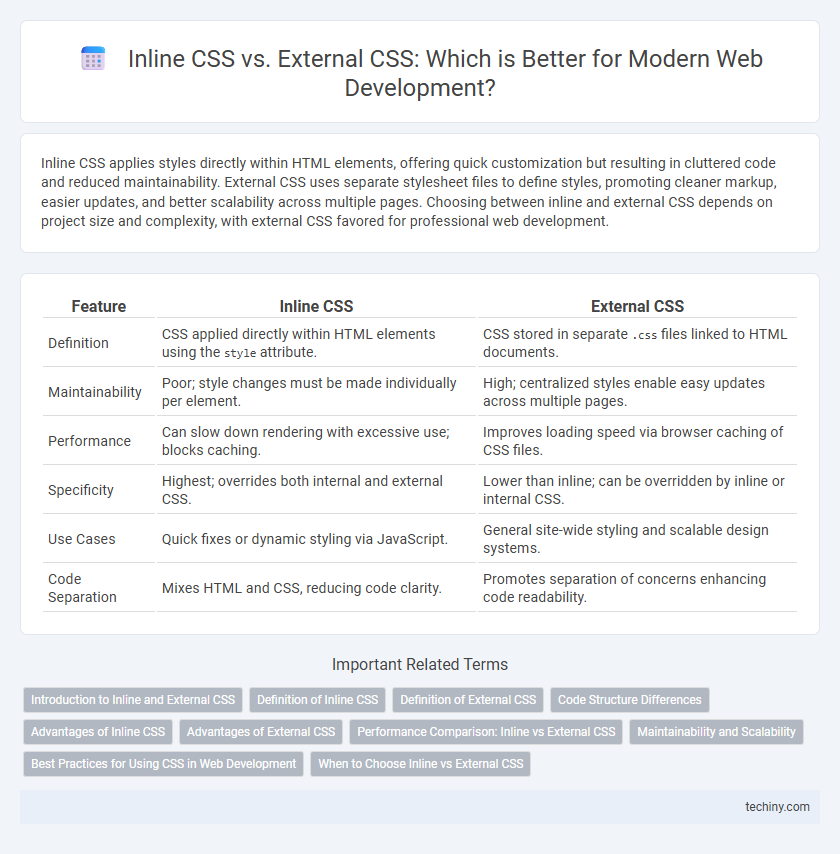Inline CSS applies styles directly within HTML elements, offering quick customization but resulting in cluttered code and reduced maintainability. External CSS uses separate stylesheet files to define styles, promoting cleaner markup, easier updates, and better scalability across multiple pages. Choosing between inline and external CSS depends on project size and complexity, with external CSS favored for professional web development.
Table of Comparison
| Feature | Inline CSS | External CSS |
|---|---|---|
| Definition | CSS applied directly within HTML elements using the style attribute. |
CSS stored in separate .css files linked to HTML documents. |
| Maintainability | Poor; style changes must be made individually per element. | High; centralized styles enable easy updates across multiple pages. |
| Performance | Can slow down rendering with excessive use; blocks caching. | Improves loading speed via browser caching of CSS files. |
| Specificity | Highest; overrides both internal and external CSS. | Lower than inline; can be overridden by inline or internal CSS. |
| Use Cases | Quick fixes or dynamic styling via JavaScript. | General site-wide styling and scalable design systems. |
| Code Separation | Mixes HTML and CSS, reducing code clarity. | Promotes separation of concerns enhancing code readability. |
Introduction to Inline and External CSS
Inline CSS applies styles directly within an HTML element using the style attribute, allowing rapid, element-specific customization without requiring a separate file. External CSS involves linking an external stylesheet to an HTML document, enabling centralized style management and consistent design across multiple pages. Choosing between inline and external CSS impacts website maintainability, load times, and scalability in web development projects.
Definition of Inline CSS
Inline CSS refers to styles applied directly within an HTML element using the style attribute, allowing for immediate and specific styling adjustments. This method embeds CSS rules inside the HTML tag, making it useful for quick changes or unique element customization without affecting other parts of the webpage. Inline CSS can impact maintainability and scalability since it mixes content with presentation, differing from external CSS, which separates design from structure.
Definition of External CSS
External CSS refers to a stylesheet stored in a separate .css file linked to an HTML document using the tag within the
section. This method allows for centralized style management, enabling consistent design across multiple web pages and faster loading times due to browser caching. External CSS enhances maintainability and scalability in web development by separating content structure from presentation.Code Structure Differences
Inline CSS applies styles directly within HTML elements using the style attribute, leading to cluttered and less maintainable code structure. External CSS separates style rules into dedicated stylesheet files, promoting cleaner HTML markup and easier updates across multiple pages. This modular approach enhances scalability and improves overall project organization in web development.
Advantages of Inline CSS
Inline CSS offers precise, immediate style application directly within HTML elements, enabling rapid visual adjustments without switching files. It enhances page load speed for small-scale styles by reducing HTTP requests compared to external CSS files. Inline CSS is highly effective for testing and debugging unique element formatting in real-time during web development.
Advantages of External CSS
External CSS improves website maintainability by centralizing style rules in a single file, enabling easy updates across multiple pages. It enhances loading efficiency through browser caching, reducing page load times on repeat visits. External CSS also supports better code organization and scalability, essential for large web projects and collaborative development.
Performance Comparison: Inline vs External CSS
Inline CSS applies styles directly within HTML elements, resulting in faster initial rendering since styles are loaded with the HTML, but it increases page size and reduces caching efficiency, negatively impacting overall performance on larger websites. External CSS files enable browser caching across multiple pages, significantly improving load times for returning visitors and reducing HTML file size, though the initial request to fetch external stylesheets may slightly delay first paint. For optimal performance, external CSS is preferred in scalable web development due to better maintainability and caching benefits, while inline CSS is suited for quick, small style adjustments or critical above-the-fold content to enhance perceived load speed.
Maintainability and Scalability
External CSS significantly improves maintainability by centralizing style rules in a single or few files, enabling easier updates and consistency across multiple web pages. Inline CSS, while offering quick, element-specific styling, complicates scalability due to repetitive code and difficulty in managing large projects. For scalable web development, external CSS supports modular architecture and best practices like DRY (Don't Repeat Yourself), enhancing long-term project efficiency.
Best Practices for Using CSS in Web Development
External CSS is preferred for best practices in web development due to improved maintainability, faster page load times through caching, and better separation of content and design. Inline CSS should be limited to quick testing or unique style overrides, as it can lead to code redundancy and hinder scalability. Organizing stylesheets externally enhances teamwork efficiency and supports cleaner, modular code architecture.
When to Choose Inline vs External CSS
Inline CSS is best suited for quick styling of a single element or when testing small changes without affecting other parts of the website. External CSS is ideal for maintaining a consistent style across multiple pages and improving site performance through caching and reduced code duplication. Choosing external CSS enhances scalability and ease of maintenance for larger web projects, whereas inline CSS provides immediate, targeted styling control.
Inline CSS vs External CSS Infographic

 techiny.com
techiny.com